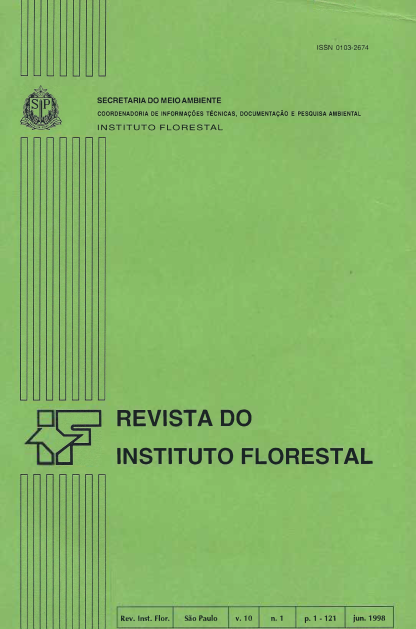RECRUTAMENTO DE PLÂNTULAS DE Genipa americana L. (RUBIACEAE) EM MATA RIPÁRIA
DOI:
https://doi.org/10.24278/2178-5031.1998101536Keywords:
Genipa americana, riparian forest, germination, seedling, seedling recruitment, forest dynamics, demographyAbstract
Seedling recruitrµent of Genipa americana L. was studied in riparian forest by sampling transects installed from adult trees in Northwest-Southeast (NW-SE) and Southwest Northeast (SW-NE) directions. Samples of four square meters with distances varying between 0 to 30 m of the trunk were instalred. Fifty-four collections were done, at one-week intervals, from the beginning of germination. The units of monitormg were bouquets emerged of dropped fruits in tho soil. Results were expressed in terms of density, survival and seedling densicy, distance and age ratio along the year. As supplementary data each matnx tree was charactenzed m terms of crown. diameter, distance from gaps ang light vanation on each sàmple. Influence of different light conditions on establishment was indicated. Results shown seeds abundance; massive gemunation; fali intensity close to mother trees; aensity as limiting factor to recruitment; low survival rate in some distance from mother trees, in gap conditions.
Downloads
References
AUGSPURGER, C. K. 1983. Seed dispersai of the tropical tree Platypodium elegans, and the scape of its seedlings from frugal pathogens. Journal of Ecology, London, 71 :759-771.
____ . 1984. Seedling survival of tropical tree species: interactions of dispersai distance, lightgaps, and pathogens. Ecology, New York, 65:1705-1712.
BROKAW, N. V. L. & SCHEINER, S. M. 1989. Species composition in gaps and structure of a tropical forest. Ecology, New York, 70(3):538-541.
CANHAM, C. D. 1989. Different responses to gaps among shade-tolerant tree species. Ecology, New York, 70(3):548-556.
CRESTANA, C. de S. M. et ai. 1992. Fenologia , do fruto de Genipa americana L. (Rubiaceac) em mata ciliar do Rio Moji-Guaçu, SP. IPEF, Piracicaba, ( 45):31-34.
CRESTANA, C. de S. M. 1996. Dispersão de frutos/sementes de Genipa americana L. (Rubiaceae) em mata ciliar do Rio Moji Guaçu, SP. Rev. Inst. Flor. , São Paulo 8(2):213-221. ,
CONNELL, J. H. 1971. On the role of natural enemies in preventing competitive exclusion in some marine animais and in rainforest trces. ln: BOER, P. J. den & GRADWELL, G.-R. (eds.) Dynamics of populations. Wageningen, Holland, Centre for Agricultural Publishing and Documentation. p. 298-312
DENSLOW, J. S. 1980. Gap partitioning among tropical rain forest trees. Biotropica, St. Louis, 12: 47-55. (Tropical Succession)
DIRZO, R. & DOMÍNGUEZ, C. A. 1986. Seed shadow, seed predation and the advantages of dispersai. ln: ESTRADA, A. & FLEMING, T. H. (eds.) Frugivores and seed dispersai. The Netherlands, Dordrecht, Dr. W. Junk Publishers. V. 19. p. 237-249.
DUKE, J. A. 1965. Keys for thc identifícation of seedlings of some prominent woody species in light forests types in Puerto Rico. Ann. Mo. Bot. Garden, St. Louis, 52(3):314-350.
DE VUONO, Y. S.; BARBOSA, L. M. & BATISTA, E. A. 1982. A Reserva Biológica de Mogi-Guaçu. ln: CONGRESSO NACIONAL SOBRE ESSÊNCIAS NATIVAS, Campos do Jordão - SP, set. 12-18, 1982. Anais ... Silvic. S. Paulo, São Paulo, 1 6A :548-558. Pt. 1. (Edição Especial)
FENNER, F. 1985. Seed Ecology. London, Chapman and Hall. 15 l p.
HARPER, J. L. & WHITE, J. R. 1974. The demography of plants. Ann. Rev. Eco/. System. 5:419-463.
HOWE, H. F. 1989. Scatter and clump-dispersal and seedling demography: hypothesis and implications. Oecologia, Berlin, (79):417-426.
___ . & WESTLEY, L. C. 1988. Ecological relationships of plants and animais. New York, Oxford University Press. 273p.
JANZEN, D. H. 1970. Herbivores and the number of tree species in tropical forest. The American Naturalist, Chicago, (104):501-528.
LIEBERMAN, D. & LIEBERMAN, M. 1987. Forest tree growth and dynamics at' La Selva, Costa Rica (1969-1982). Journal of Tropical Ecology, Cambridge, 3:347-358.
MARTÍNEZ-RAMOS, M. & ÁLVAREZ-BUYLLA, E. 1986. Seed dispersai gap dynamics and tree recruitment: the case of Cecropia obtusifolia at Los Tuxtlas, Mexico. ln: ESTRADA, A. & FLEMING, T. H. (eds.) Frugivores and seed dispersai. The Netherlands, Dordrechet, Dr. W. Junk Publishers. v. 25. p. 333-346.
PICKETT, S. T. A. 1983. Differential adaptation of tropical specics to canopy gaps and its role conununity dynamics. Tropical Ecology, Varanasi, 24(1):68-84.
PIJL, L, van der. 1982. Principies of dispersai in higher plants. 3ed. Berlin, Springer-Verlag. 214p.
POULSON, T. L. & PLATT, W. J. 1989. Gap light regimes influence canopy tree diversity. Ecology, New York, 40(3):553-555.
SARUKHÁN, J. 1978. Studies of plant demography: Ranunculus repens L., R. bulbosus L. and R. acris L. II. Reproductive strategies and seed population dynamics. Journal of Ecology, London, 62: 151-177.
____ . 1980. Demographic problems in tropical systems. ln: SOLBRIG, O. T. (ed.) Demography and evolution in plant populations. Oxford, England, Blackwell Scientifíc. 219p. (Botanical Monographs, 15)
SCHUPP, E. W. 1990. Annual variation in seedfall, postdispérsal predation and recruitment of neotropical tree. Ecology, New York, 71 (2):504-515.
SORK, V. L. 1987. Effects of predation and light on seedling establishment in Gustúvia superba. Ecology, New York, 68(5): 134 1-1350.
VASQUEZ-Y ÁNES, C. & OROZCO-SEGOVIA, A. 1984. Ecophysiology of seed germination in the tropical humid forests of the world: a review. ln: MEDINA, E.; MOONEY, H. A. & VASQUEZ y ÁNES, C. (eds.). Physiological ecology of plants of the wet tropics. La Haya, Dr. W. Junk Public. p. 37-51.















